Prince Philip and Prince Charles' Complicated Relationship: Honor, Loyalty and Tangling Over Life Choices

What are dads for, if not to advise their sons on how to get their jollies without embarrassing the family?
Prince Philip had those words of wisdom for his son, Prince Charles, when the hopelessly not-in-love future king sought his father's counsel about what he, as a man married to one woman but wanting to be with another, should do.
"My father-in-law said to my husband, 'If your marriage doesn't work out, you can always go back to her after five years,'" Princess Diana recapped their exchange, as revealed in a 2017 Channel 4 special that utilized taped private conversations between the Princess of Wales and her voice coach. "Which is exactly—I mean, for real I knew that it had happened after five—I knew something was happening before that but the fifth year I had confirmation."
Former royal butler Paul Burrell wrote in his 2003 book A Royal Duty, "Both the Prince and the Princess were told that they must learn to compromise, be less selfish and try to work through their difficulties for the sake of the monarchy, their children, the country and its people."
But as the world knows, Diana wasn't willing to be in a marriage of three forever, and Charles wasn't willing to quit Camilla Parker Bowles, so the old-fashioned way more common to the days of Philip's youth went by the wayside in 1992, when Charles and Diana—not content just to live separate lives—actually separated.
Prince Philip's Life in Photos
After Charles and Camilla married in 2005, it was determined that out of respect for Diana, the new Duchess of Cornwall would be Princess Consort instead of Queen Consort once Charles became King.
But fast forward to now and it may be that enough time has gone by so that Camilla can become Queen Consort.
"It's now 21 years since the death of Diana in 1997 and public attitudes have changed, and continues to do so, with a greater acceptance of Camilla today than there was say 13 years ago...," former royal press secretary Dickie Arbiter, told Hello! in 2018. "The Duchess through her work has shown herself to be a good support to her husband and to the Queen thus making her not only an asset to the country but to the institution of monarchy."
And while more than a few family matters refused to unfold the way Charles' mother or father once envisioned they would, Prince Philip, who died April 9 at the age of 99, having been the queen's devoted consort for 69 years, knew a thing or two about the importance of good support.

If all goes according to the plan currently in place, Prince Charles will become the King of England (and assorted other places constituting the Commonwealth of Nations), and he'll fare better if he has a strong spouse by his side, as his mother did for all those years.
As the eldest son of Queen Elizabeth II, Charles has been destined to assume the throne at some point since his birth on Nov. 14, 1948, when about 3,000 people gathered outside Buckingham Palace to await the announcement of his birth. Even his mother had 10 whole years of relatively expectation-less childhood before her father shockingly became King George VI when his brother abdicated, forever altering the line of succession and putting young "Lilibet" next in line for the throne.
So when Charles was born, his mother and father already knew that the day would come when their lives, as little as they didn't already, would revolve entirely around the crown.
"I think of you so much with a sweet baby of your own," Philip's mother, Princess Alice of Battenberg, wrote to him upon Charles' arrival, "of your joy and the interest you will take in all of his little doings. How fascinating nature is, but how one has to pay for it in the anxious trying hours of the confinement." (Elizabeth was in labor for 30 hours.)
Philip was, indeed, in a "wonderful mood," according to Philip Eade's 2011 biography Prince Philip: The Turbulent Early Life of the Man Who Married Queen Elizabeth II.

Philip and Elizabeth moved into Clarence House in 1947, and the young couple embarked on an 18-month renovation that came in £28,000 over budget (some things never change). Once it was finished, John Gibson, who as nursery footman was responsible for walking Prince Charles in his pram and keeping the pram polished, later wrote that his surroundings were "luxury I could never before have dreamed of."
Elizabeth became Queen when Charles was 3, having spent many of his early days away in Malta, where Philip was still stationed with the Royal Navy. Even once they returned, however, it being the 1950s and all, Philip wasn't exactly going to be a hands-on dad. He cared deeply about his firstborn son, and once he was permanently back in England he helped establish Charles' lifelong love of the outdoors, teaching him to shoot, ride, fish and swim.
But Charles later remembered "being cowed by the forceful personality of his father," according to Jonathan Dimbleby's 1994 book The Prince of Wales: A Biography.
His mother was "not indifferent so much as detached" from her children and what friends remembered as her husband's often "bullying" or "belittling" behavior toward Charles. Both parents, for instance, shook hands with their 5-year-old son and 3-year-old daughter, Princess Anne, upon their return from a nearly six-month tour abroad in 1954.
Queen Elizabeth II & Prince Philip's Romance Through the Years
"Perhaps having married someone who is like Philip, it is difficult to go on expressing emotion to an unemotional person," mused the Queen's cousin Margaret Rhodes, according to Tina Brown's The Diana Chronicles, which compares Philip's style to onetime U.S. Defense Secretary Donald Rumsfeld, "another ball-shriveling 'leader of men.'"
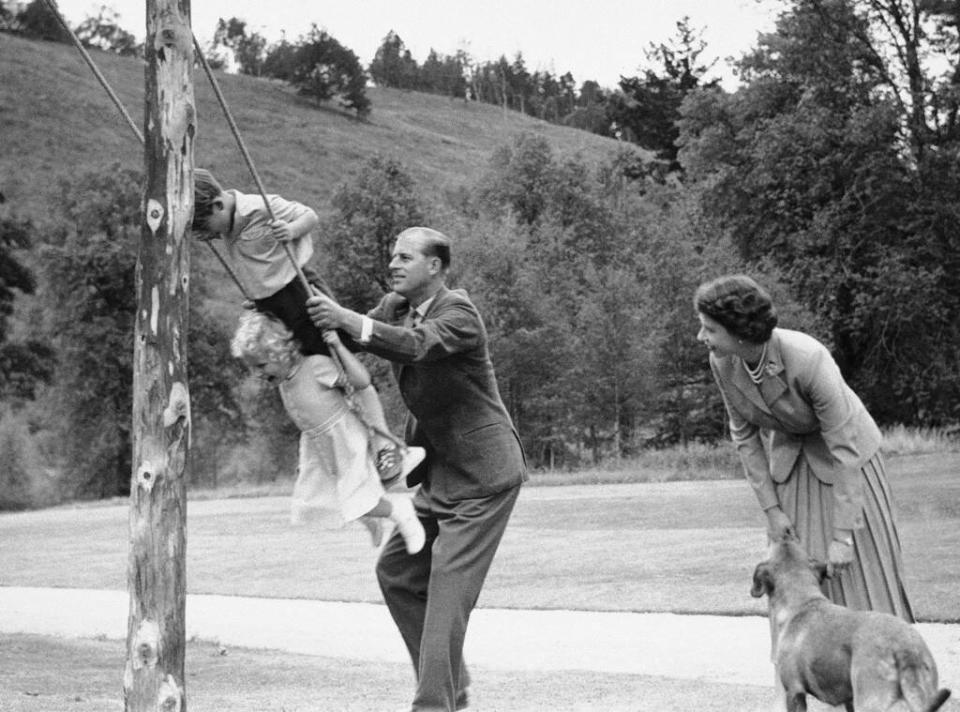
"Philip is very good with children," countered Philip's cousin Patricia, daughter of Lord Louis "Dickie" Mountbatten, according to Sally Bedell Smith's 2017 biography Prince Charles: The Passions and Paradoxes of an Improbable Life. "It is quite untrue that he didn't care. He was trying to help Charles develop character in his life, knowing the life he had to leave."
Meanwhile, Charles' great-uncle Dickie Mountbatten (who had a famously open marriage with Countess Edwina Mountbatten), was a majorly influential figure in his life. In 1974, Dickie advised his nephew in a letter to "sow his wild oats and have as many affairs as he can before settling down."
Philip already had to come to terms with what marrying Elizabeth meant before they did so on Nov. 20, 1947, knowing that he'd have to give up his naval career and become his wife's—and therefore the monarchy's—most important champion. But he was also the man of the house, and the queen tasked him with organizing the household—or at least supervising the organizing of the household—and she continued to consult him on every important decision she made for the rest of his life.
Prince Charles was introverted, less so than Princess Anne, who handled their father's characteristic ribbing more naturally. As a child Charles gravitated toward his maternal grandmother, Elizabeth, the Queen Mother, and they would remain close until her death in 2002 at the age of 101. Charles was more artistic and cerebral than athletic (though he was a good shot and an avid polo player), which he guessed correctly disappointed his father.
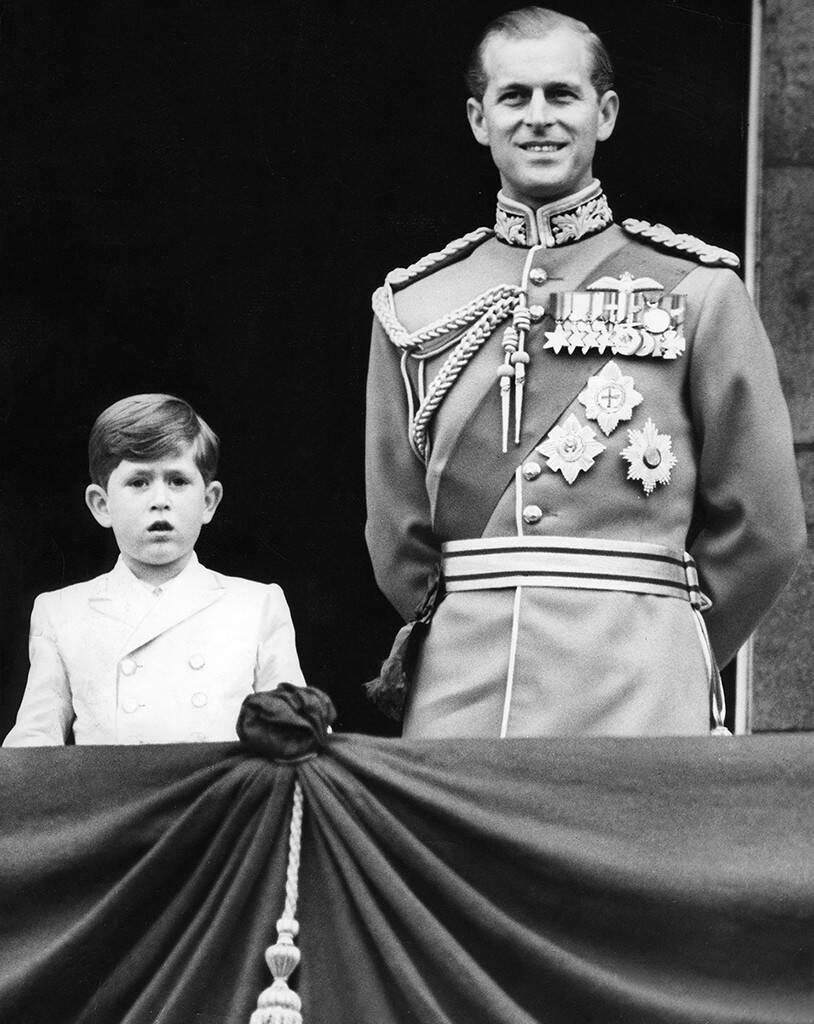
"I want him to be a man's man," Philip reportedly said on various occasions, having procured a cricket bat for his son by the time he was 1, according to Eade.
Intent on toughening his son up, Philip insisted he go to his alma mater, Gordonstoun in Scotland, instead of the closer Eton, which the Queen Mother recommended (and where Charles later sent his boys, Prince William and Prince Harry). But Philip purposely wanted Charles to be outside his comfort zone, far away from the cushy confines of Clarence House, and put his foot down.
Philip, a seasoned pilot, flew Charles to Scotland himself.
According to all accounts, Charles' first months at Gordonstoun were miserable, but Philip refused to let him transfer.
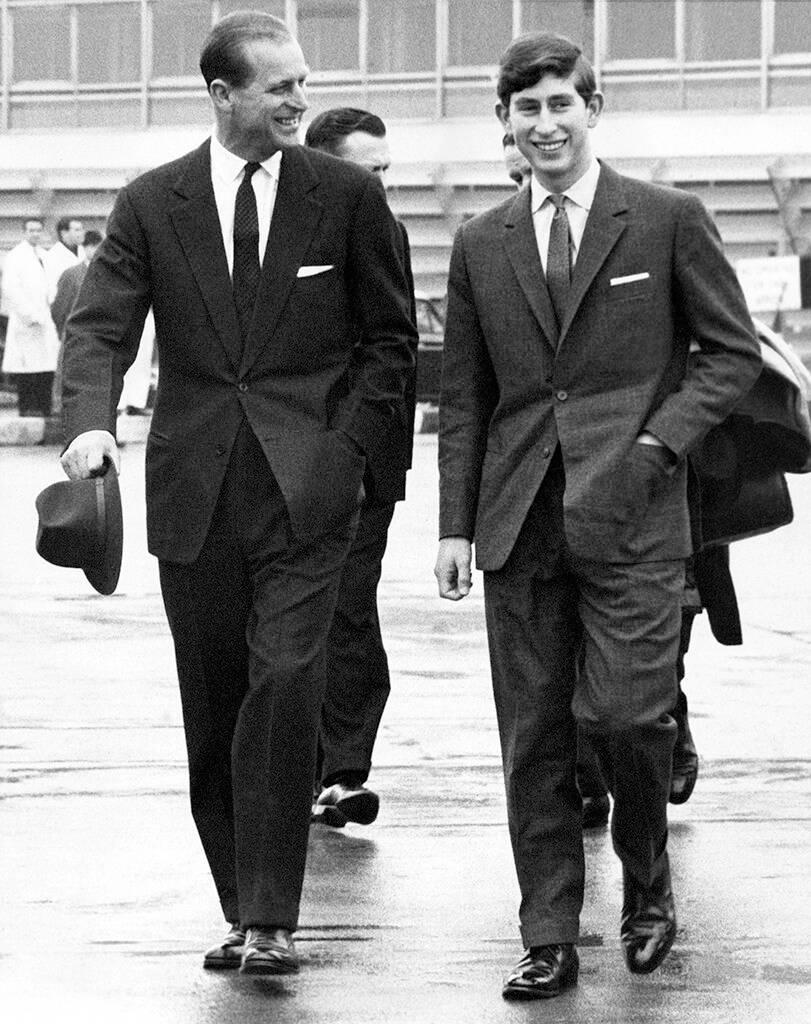
"Prince Philip is bluff, outspoken, hearty, tough and something of a bully," biographer Penny Junor says in Tim Clayton's 2001 book Diana: Story of a Princess, "and he has no patience with his eldest son's soul-searching. Sensitivity is not one of the qualities he expects in a man, and although he undoubtedly has great affection for Prince Charles, he has spent a lifetime criticizing him and quietly undermining his self-esteem."
Then, when Charles was 17, Philip arranged to send him abroad to Australia for a year, which would kindle his son's lifelong interest in exploration and anthropology.
And Dad was right: Charles came back a more confident young man, albeit still a sensitive one. He spent his final year at Gordonstoun as head boy and joined the Sea Rescue Corps. His parents threw him an 18th birthday party with a band and 150 guests at Windsor Castle.
At his father and great-uncle Dickie's urging, Charles attended Trinity College, Cambridge, where he became the first heir to the British throne to earn his university degree. After that there were stints in the Royal Air Force and the Royal Navy and, like his father, he became a pilot. He also followed in Philip's footsteps as a conservationist and committed environmentalist, local agrarian concerns destined to dominate much of Charles' time in the future.
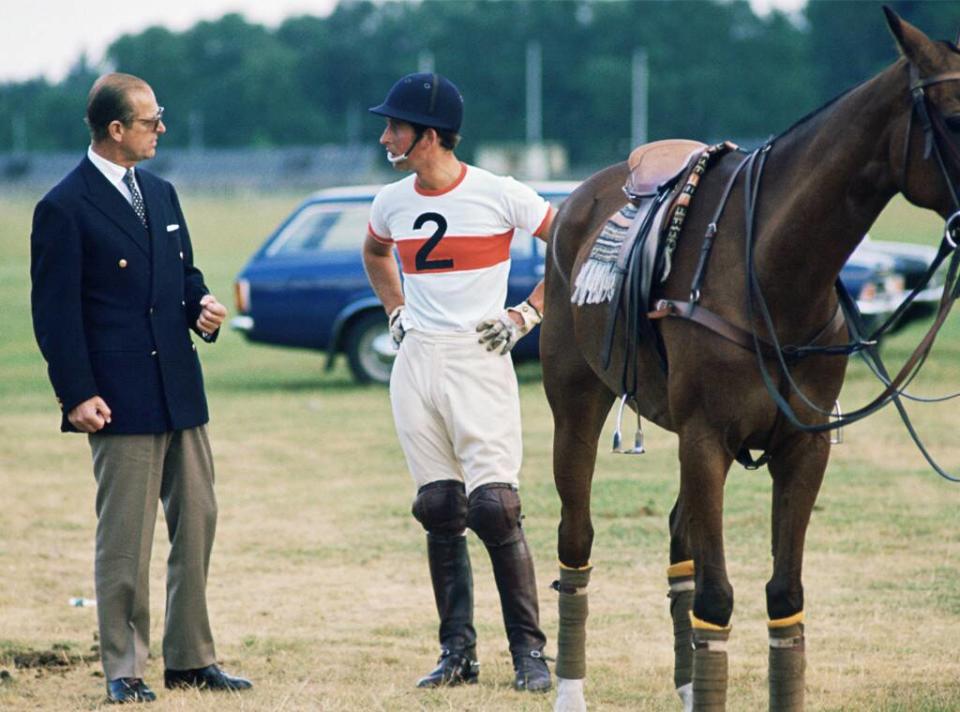
Philip, a painter himself, supported Charles' efforts as an artist, though even the prince's choice of medium—watercolors, rather than oils like his father—were also indicative of a different sensibility.
Celebrity Deaths: 2021's Fallen Stars
At the same time, young Charles was taking Dickie Mountbatten's advice, plowing through girlfriends—some of them married—at a rapid clip. He first met Camilla Shand in 1971—and she proved the one who got away when she married British Army Major Andrew Parker Bowles (who also dated Princess Anne) in 1973.
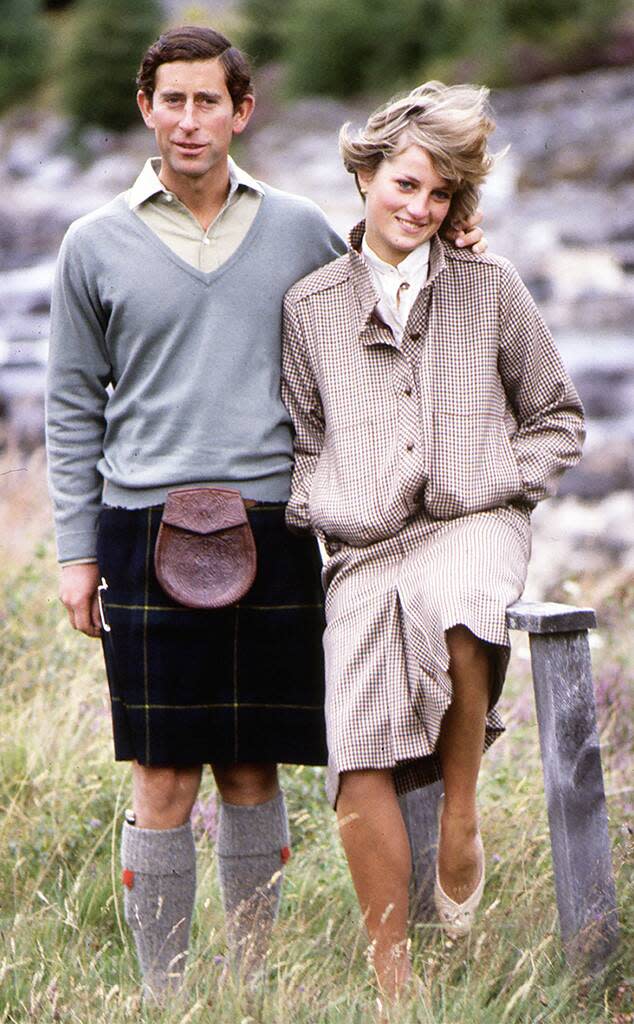
Charles first laid eyes on 16-year-old Lady Diana Spencer in 1978 when he was invited to Althorp, her family's estate, by one of his paramours, her older sister Lady Sarah Spencer. At his 30th birthday party, held at Buckingham Palace, Diana watched Charles dance with her sister, Camilla and others.
Andrew Parker Bowles was a friend of the Queen Mother and her circle, so he and Camilla were never far from the center of Charles' universe. Charles and Camilla remained confidantes and, according to The Diana Chronicles, their affair was rekindled in 1979 when Charles was grief-stricken over the death of Uncle Dickie, who was killed along with his teenage grandson and another boy when an assassin's bomb blew up his fishing boat.
Though they were going mad over Charles' poorly kept secret, neither the queen nor Philip said much about their son's many indiscretions. Philip did at one point write his son a letter chiding him for having "paraded" one of his girlfriends around. They just hoped Charles would settle on someone appropriate to marry, and the virginal Diana happened to fit the bill.
Despite their myriad differences and a 12-year age gap, Charles and Diana embarked on a romance in July 1980, around when she turned 19. The tabloids were all over the couple, and Diana in particular, and, though denied by the Palace, a positively scandalous headline in the Daily Mirror—"Royal Love Train," with the report that they had spent two nights together aboard the Royal Train—set off endless chatter about when, or if, Charles was ever going to make an honest woman of her.
In January 1981, Philip sent his son another one of his famous letters, urging him to go one way or the other—propose or break up. Charles only read it one way.
In their televised engagement interview, aired on Feb. 24, 1981, Charles said he was "delighted and happy." Asked rhetorically if he was "in love" with Diana, he said, "whatever 'in love' means."
7 Ways Princess Diana Forever Changed What it Means to Be a Royal
It became apparent early on that, no matter how much people in general adored Diana, and how much of a splash she made everywhere she went, Charles had not picked the right option proposed to him by his father.
Diana suffered from severe postpartum depression after giving birth to Prince William in 1982 and rarely left the house for about eight months after his christening. Per Bedell Smith's Diana in Search of Herself, Diana showed up late to the annual Festival of Remembrance commemorating Britain's war dead, and an onlooker described seeing Philip "looking daggers" at his daughter-in-law in the royal box.

Charles, however, was determined to be a more present father than his own had been, and he succeeded at that, making the unprecedented decision to bring 9-month-old William with him and Diana on a six-week royal tour of Australia and New Zealand. Prince Harry was born in 1984 and Charles gave the kids baths, read them stories and was otherwise very affectionate—and was publicly rewarded for his efforts, just as William would be when he became a father, by being accused of being a part-time royal.
Unlike what William would have with his in-laws one day, Diana didn't have a close personal relationship with the queen and Philip, the monarch gracious but emotionally reserved and Philip friendly and funny but not fatherly. Meanwhile, Charles eventually took up with Camilla again and his parents were said to have thought that their son having a "safety valve" was better than getting a divorce.
But then Princess Anne divorced husband Capt. Mark Phillips. Her mother and father weren't happy about it, but they had already been separated for three years, since a tabloid published love letters written to Anne from Commander (now Vice Admiral) Timothy Laurence. Anne and Timothy, her mother's former equerry, have been married since 1992, tying the knots months after her divorce was finalized.
When the Royal Family Really Has a Scandal, They Don't Mess Around
After the Andrew Morton book Princess Diana: Her True Story in Her Own Words was published in 1992, embarrassing Charles and his family to no end, Philip wrote his son a letter praising his stoicism. But it was his mother whom Charles had to talk to if he was seriously considering leaving his wife.
There are conflicting takes on how Philip received the mercurial Diana, though all may be true since the nature of the Princess of Wales' relationship with the royal family changed so drastically over the 15 years she was married to Charles, including the three years they spent separated. Diana later said that Philip raged at her during a visit to Windsor Castle, but her father-in-law proceeded to write her multiple letters explaining the importance of royalty loyalty and why it wasn't good to be airing the family's dirty laundry to anyone.
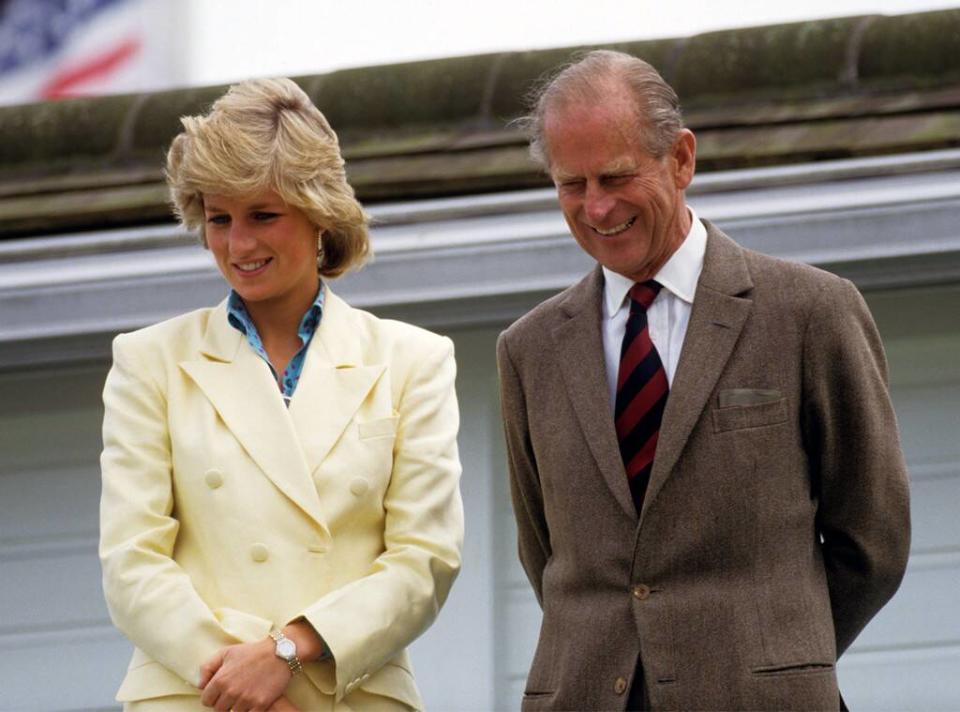
In 1992, unhappy about the pending separation, Philip reportedly wrote to Diana, "We never dreamed he might feel like leaving you for her. I cannot imagine anyone in their right mind leaving you for Camilla. Such a prospect never even entered our heads." In another letter, however, he pondered what Diana could've done differently, asking, "Can you honestly look into your heart and say that Charles's relationship with Camilla had nothing to do with your behavior towards him in your marriage?"
"[Diana] never shredded the letters," Burrell wrote in A Royal Duty. "Instead, she tied them into a bundle and kept them, a deliberate preservation of the truth, and she made several photocopies that she dispatched to friends she trusted." (Burrell was accused of stealing items from Diana's estate but theft charges were dropped in 2002 after it was revealed he had told the Queen he had the items.)
Then Dimbleby's biography The Prince of Wales came along in 1994, further scandalizing the queen and Philip.
"I've never made any comment about any member of my family in 40 years, and I'm not going to start now," the Duke of Edinburgh tersely told the Telegraph at the time.
Princess Diana's Personal Photo Album
However he felt about her in the final years of her life, though, it was Prince Philip who was responsible for one of the most iconic images to come out of the 1990s, let alone from Princess Diana's funeral in 1997.
"If you don't walk, you may regret it later," Philip told a 15-year-old Prince William, who along with Harry was resisting their father's entreaty to walk behind their mother's casket in the procession, which was watched on TV by an estimated 2.5 billion people.
"I think you should do it," their grandfather encouraged. "If I walk, will you walk with me?"
Tina Brown wrote that Philip "mellowed a lot" in the years after Diana's death—and besides, he wasn't raised, neither in practice or in time period, to be a doting dad. His era wasn't exactly churning out attentive, sensitive fathers.

In 1998, a series of celebrations were held leading up to Charles' 50th birthday that November, including a variety show at the Lyceum Theater during which Geri Halliwell sang "Happy Birthday," Marilyn Monroe-style. There was also a reception at Hampton Court Palace with about 200 guests, which marked Camilla's first appearance at one of Charles' official royal engagements—though they were careful not to actually speak in front of people.
Charles' parents also hosted a party for him at Buckingham Palace, at which Camilla was not among the 850 guests invited.
On Charles' actual birthday, Nov. 14, 1998, Camilla momentously was his date, receiving guests alongside him as hostess, at a party at his country estate, Highgrove—which his parents and siblings did not attend.
Their first official appearance as a couple occurred Jan. 28, 1999, at Camilla's sister Annabel Elliot's 50th birthday party. However, Camilla was not among the guests when Charles' brother Prince Edward married Sophie Rhys-Jones that June. Camilla actually wouldn't have any sort of face time with the queen until 2000 when they had a nod-and-curtsy at a birthday barbecue for a cousin of Charles' at Highgrove, their first time socializing since the 1980s.
When Charles' beloved grandmother died in 2002, Camilla didn't stand with the family at the funeral, but she was in attendance. As time went by, Camilla was generally accepted as Charles' companion, but she wasn't making "official" appearances—and the omelet finally hit the fan in the fall of 2004, when Camilla was demoted to your average guest on the bride's side at the wedding of Charles' godson Edward van Cutsem. Camilla, originally invited by the groom, refused to attend—and Charles, agonizing over the decision, stayed away too.
By then, it was clear that Charles, who seemed content not to remarry, needed to make another decision.
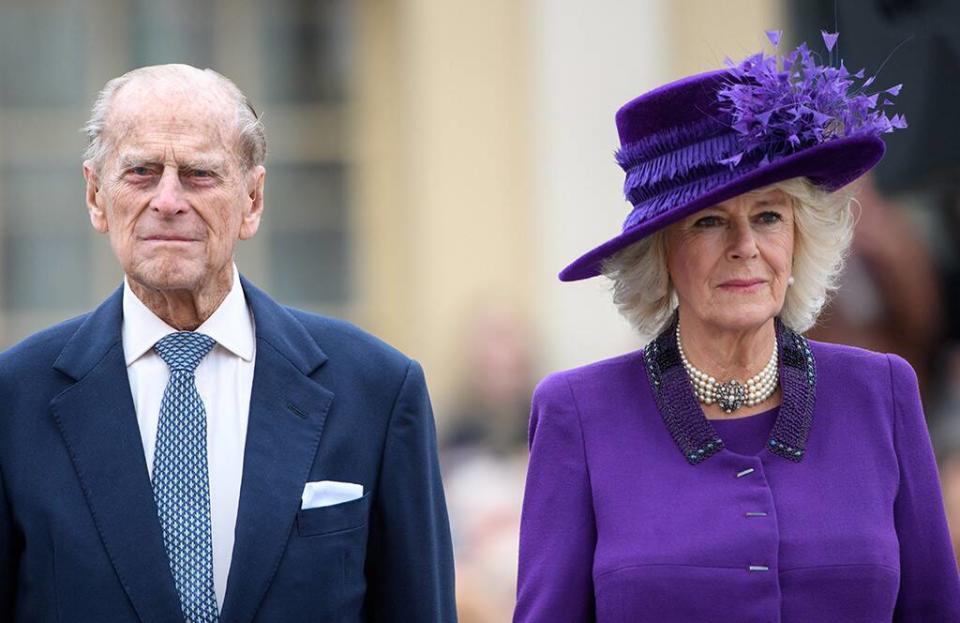
Much was made of the Queen (and therefore Prince Philip) not attending the ceremony when Charles and Camilla finally married on April 9, 2005, at Windsor's Guildhall, Tom Bower describing Charles as "inconsolable" over his parents' absence in his 2018 book Rebel Prince: The Power, Passion and Defiance of Prince Charles.

It was later explained that the Queen merely didn't think her presence was necessary, it being a civil rather than a religious ceremony (which Charles would've preferred, but a couple of divorced people can't be choosers in England). And sure enough, the Queen and Philip did attend the Service of Prayer and Dedication at St. George Chapel at Windsor Castle, where Charles' son Prince Harry later married divorcée Meghan Markle in May 2018.

At a reception hosted by the Queen for hundreds of their nearest and dearest, the mother of the groom famously said in toasting the newlyweds, "I have two important announcements to make. The first is that Hedgehunter has won the Grand National," she said in reference to the steeplechase that also took place that morning, delayed 25 minutes so the BBC could televise the prayer service.
As for Charles and Camilla, "They have overcome Becher's Brook and The Chair and all kinds of other terrible obstacles," the Queen continued, taking up the racing theme. "They have come through, and I'm very proud and wish them well. My son is home and dry with the woman he loves."
And what a difference a decade makes. When Charles threw Camilla a 60th birthday party at Highgrove in July 2007, the Queen and Philip attended. Though by then, far more attention was paid to the presence of Kate Middleton, back together with William after a brief breakup.
The monarchy's future in their midst.
(Originally published Aug. 16, 2018, at 3 a.m. PT)